Indexed In
- Genamics JournalSeek
- RefSeek
- Hamdard University
- EBSCO A-Z
- Publons
- Geneva Foundation for Medical Education and Research
- Euro Pub
- Google Scholar
Useful Links
Share This Page
Journal Flyer

Open Access Journals
- Agri and Aquaculture
- Biochemistry
- Bioinformatics & Systems Biology
- Business & Management
- Chemistry
- Clinical Sciences
- Engineering
- Food & Nutrition
- General Science
- Genetics & Molecular Biology
- Immunology & Microbiology
- Medical Sciences
- Neuroscience & Psychology
- Nursing & Health Care
- Pharmaceutical Sciences
Case Report - (2020) Volume 17, Issue 4
Robinow Syndrome as a Prenatal 5D Ultrasound Diagnosis: A Case Report in Mansoura Fetal Medicine Unit
Sara A Mohamed*, Ahmed Elzayadi, Mohamed Eltatongy and Hend Shalaby2Division of Translation Research, Department of Obstetrics and Gynecology, Medical College of Georgia Augusta University, Augusta, GA 30912, USA
Received: 30-Jan-2020 Published: 25-Feb-2020, DOI: 10.35248/2090-7214.20.17.342
Abstract
Robinow syndrome, named after Doctor Meinhard Robinow who first reported a new type of dwarfism in 1969. Rarely, Robinow syndrome aka fetal face syndrome is genetically inherited heterogeneous disorder characterized mainly by limb shortening (mesomelia), dysmorphic facial features, and abnormal genitalia (ambiguous). This report presents depicts the antenatal ultrasound findings in a case of autosomal dominant Robinow syndrome diagnosed at 22 weeks’ gestation, for a Robinow pregnant female with history of two positive siblings. This case study demonstrates the role of the new 5D technology of ultrasound in the prenatal diagnosis correlating to postnatal findings, narrowing down the differential diagnosis.
Keywords
Robinow syndrome; Prenatal diagnosis; 5D ultrasound; Fetal abnormalities
Introduction
Robinow syndrome reported mode of inheritance fall in two main categories (dominant and recessive) besides the newly arisen mutations [1]. Interestingly, the syndrome wide range of phenotypic presentations reflects the allelic heterogenicity. In other words; the recessive form tends to be more severe than the dominant form [2,3]. Lately, Robinow syndrome genetic mapping revealed ROR2 gene, on the long arm of chromosome 9 in recessive form and gene WNT5A located on short arm of chromosome 3 in dominant from [4,5].
Despite, the paucity of data about the aforementioned syndrome the incidence reported as 1/500,000 births and there are rising numbers of cases since the first report in 1969. To our knowledge, there were only 4 prenatal reported cases two of them in families with affected siblings and two without affected child using two/three dimensions ultrasound [6].Currently, Prenatal diagnosis plays a crucial role in the evolution of many rare or undiagnosed disorders as it permits the parents to be informed about such conditions and moreover; the prognosis [7].
Happening new technology in ultrasound enabled clinicians to optimize their scan findings and refining the images to utmost the diagnosis quality. The five dimensions (5D) Ultrasound new modality is the cutting-edge development in pregnancy imaging and it is patented by Samsung. 5D apprehends and combines high definition volume data to create automated images with amazing color and clarity.
In this report, we are presenting our Mansoura fetal medicine unit experience in reporting a pregnant Robinow female case had autosomal-dominant Robinow syndrome male fetus that was diagnosed antenatally using the newly introduced 5D ultrasound technology.
Case Report
This case study was approved by Mansoura faculty of medicine Institutional Review Board (MFM-IRB). The data released after informed consent with the parents. The pregnant mother was a 25 years-old third gravida second para female with no family history of consanguinity. The lady was referred to our unit for a detailed anatomical scan based on her personal history and obstetric history of having two siblings (boys) diagnosed with Robinow syndrome. She was informed that the gender of her fetus was female and the basic scan findings within normal limits. The mother denied smoking, consumption of any drugs or alcohol in early week’s gestations.
On 8-9-2019, she underwent pre-booked ultrasound examination performed with Elite WS80 Samsung scanner equipped with volumetric crystal probe (4-8 curved array transducers). The 2/3/4/5 D scan modality combination revealed longitudinal lie fetus presented cephalic and the fetal biometry was consistent with the menstrual age of 22 weeks+2 days. The fetal long bones were below the 5th centile for gestational age(FL=3.2 cm=20ws+2ds; FL/AC=17.8% (normal range 20%-24%); FL/BPD=58% (normal range 71%–8 7%) and FL/ HC=16.8% (normal range 17.7%-21.2%).
Throughout the scan period, the fetal hands showed abnormal fixation of the first three fingers with free movement of the index finger and thumb (Figure 1).
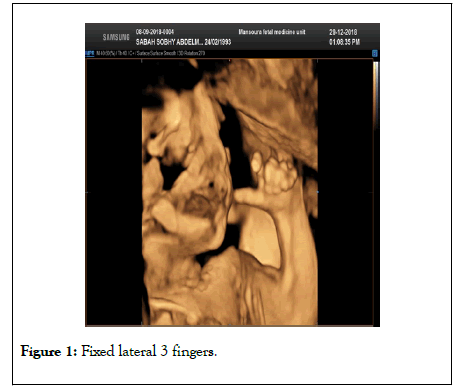
Figure 1. Fixed lateral 3 fingers.
Adding on, the fetal skull and brain were perceived normal for gestational age, the thorax and heart observed as anatomically normal. Likewise, the fetal spine and vertebrae were normal (Figure 2).
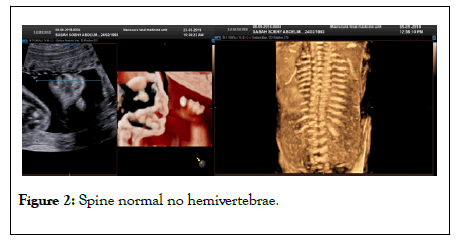
Figure 2. Spine normal no hemivertebrae.
Furthermore, the gender was assessed carefully and a normal scrotum with testicles documented with small micropenis (Figure 3).
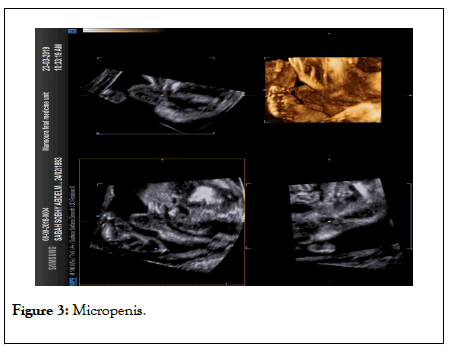
Figure 3. Micropenis.
Lastly, the fetal face was not visualized and a follow up scan was recommended. The patient appointed for a later scan 29-12-2018. The scan conducted using mainly 5 D modalities for evaluation of the fetal long bone and face realistic view (HD live) which revealed characteristic facial features of Robinow syndrome (hypertelorism, wide nasal bridge, prominent upper lip, slightly low set ear) (Figure 4).
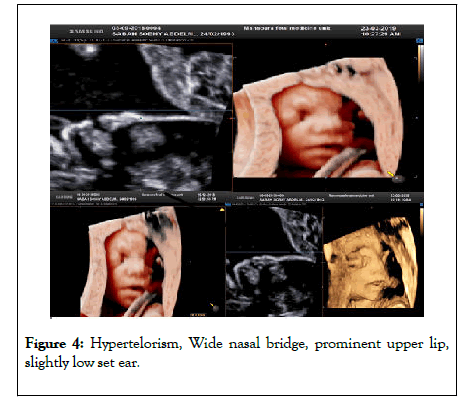
Figure 4. Hypertelorism, Wide nasal bridge, prominent upper lip, slightly low set ear.
Plus, 5D long bone volume evaluation produced refined images of the femur, humerus, radius, ulna, tibia & fibula that ensure normal bones morphometry but only below centile (short) to be the different point from skeletal dysplasia (Figure 5).Clearly, 5D evaluation of the spine documented absence of hemivertebrae which characterize the syndrome. The provisional diagnosis of autosomal dominant Robinow syndrome was made and the consultant committee opinion of the fetal medicine unit was to continue pregnancy with close observation and recommendation to deliver in the university hospital (Figure 6).
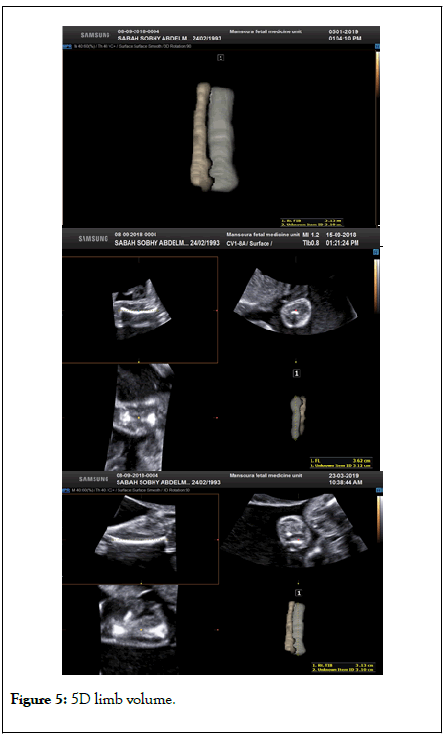
Figure 5. 5D limb volume.
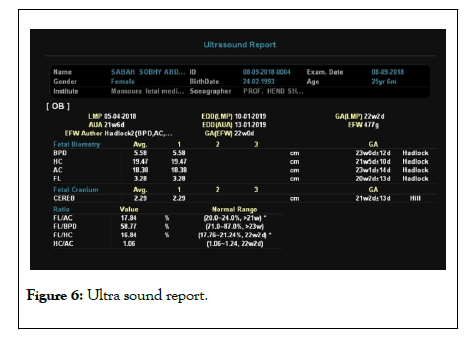
Figure 6. Ultra sound report.
At 38 weeks’ gestation, the case delivered by elective CS because she had 2 previous CS. The newborn boy was delivered in a weight of 3100 gm with reported Apgar score of 6 at 1 minute and 8 at 5 minutes (Figure 7).
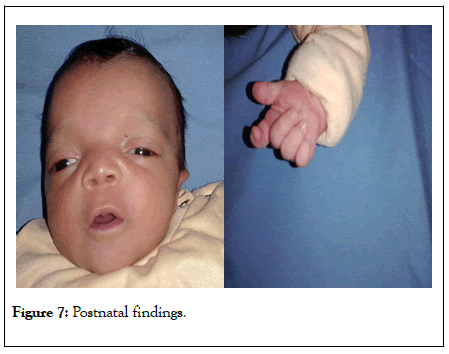
Figure 7. Postnatal findings.
The newborn morphological systematic screening was consistent with the prenatal ultrasound findings (hypertelorism, prominent eyes, wide nasal bridge, prominent upper lip, low set ears, lateral three fingers fixation, micropenis) (Figure 8).
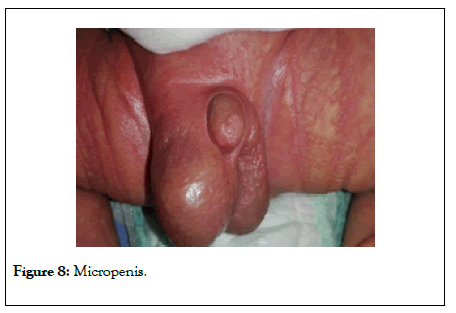
Figure 8. Micropenis.
Discussion
Up-to-date, prenatal genetic diagnosis is considered as a huge quandary. In most of the cases, the responsible genes are not yet determined. Notably, heterogeneity in allelic representation of Robinow syndrome resulted in overlapping features between the dominant and recessive form as craniofacial, skeletal and genital malformation [5]. However, these characteristics tend to be much higher and severe in the recessive phenotype.
Although our index syndrome was reported prenatally earlier in 5 distinctive reports in 5 diverse countries but they were reported differently. Instantly, Loverro et al. Reported 19 week’s dominant case with positive older child when he focused on short limbs but didn’t report the facial features [6]. On the other hand, Percin et al. described a recessive case based on first trimester scan and increased nuchal translucency (3.2 mm) with short limbs for a mother with Turkish ethnicity and affected older child [7].
The third case reported by Guven et al. was a 33 weeks pregnant woman from Turkey confirmed positive consanguinity with no previous child with the syndrome and the ultrasound showed the short limbs and hemivertebra and assigned as autosomal recessive owing to the severity of phenotypic expression [8]. The forth case, was reported by Castro et al. as autosomal dominant diagnosed prenatally at 23 weeks ’ gestation in Mexican non consangious marriage but admitted alcohol and drug consumption [9]. Lastly, Jeppesen et al. added the 3 D modality in a case from Denmark [10].
Our case is the fifth case of Robinow syndrome reported antenatally and the third autosomal dominant, moreover the first to represent the 5D Modalities in the diagnosis. The documented features in our report included the facial features prominent eyes, wide nasal bridge and everted upper lip. Importantly, adding to the diagnostic spectrum the fixed lateral 3 fingers feature that is not mentioned previously.
The patient counseled about the good prognosis of the dominant phenotype of Robinow syndrome; eighty percent have normal mental state and development in contrast to considerable risk of mental retardation in the recessive form [11,12].
Conclusions
We reported the prenatal ultrasound findings for diagnosis of Robinow syndrome with the usage of a new advanced technology 5D that overturned the image in our case from a normal scan to prenatal diagnosis of Robinow autosomal dominant male rather than female. Although no molecular genetic studies were done the ultrasound findings prenatal and postnatal supported the autosomal dominant Robinow syndrome.
Conflict of Interest
The patient ID is evident on the images. No fund interest for this report.
Fully formed consent for image release from the parents.
Authors Role
Dr Sara A.Mohamed studied the bibliography of the syndrome and drafted the manuscript, Dr Ahmed Elzayadi was the
sonographer under supervision of Professor Dr Hend Shalaby and professor Dr Mohamed Eltatongy and finally Dr Hend shalaby was the main investigator in the study.
REFERENCES
- Hosalkar HS, Shaw GJ, Shaw BA. Robinow syndrome. J Postgrad Med. 2002:48(1):50-51.
- Glaser D, Herbst J, Roggenkamp K, Tunte W, Lenz W. Robinow syndrome with parental consanguinity. Eur J Pediatr. 1989;148:652-653.
- Robinow M, Silverman FN, Smith HD. A newly recognized dwarfing syndrome. Am J Dis Child. 1969;117(6):645-651.
- Patton MA, Afzal AR, Robinow syndrome. J Med Genet. 2002;39(5):305-310.
- Person AD, Beiraghi S, Sieben CM, Hermanson S, Neumann NA, Robu ME, et al. WNT5A mutations in patients with autosomal dominant Robinow syndrome. Dev Dyn. 2010;239(1):327-337.
- Loverro G, Guanti G, Caruso G, Selvaggi L. Robinow syndrome: prenatal diagnosis. Prenat Diagn. 1990;10(2):121-126.
- Percin EF, Guvenal T, Cetin A, Percin S, Goze F, Arici S. First-trimester diagnosis of Robinow syndrome. Fetal Diagn Ther. 2001;16:308-311.
- Guven MA, Batukan C, Ceylaner S, Uzel M, Ozbek A, Demirpolat G. Prenatal and postnatal findings in a case with the autosomal recessive type of Robinow syndrome. Fetal Diagn Ther. 2006;21:386-389.
- Castro S, Peraza E, Barraza A, Zapata M. Prenatal diagnosis of Robinow syndrome: A case report. J Clin Ultrasound. 2014;42(5):297-300.
- Jeppesen BF, Hove HB, Kreiborg S, Hermann NV, Darvann TA, Jørgensen FS. Prenatal diagnosis of autosomal recessive Robinow syndrome using 3D ultrasound. Clin Case Rep. 2017;5(7):1072-1076.
- Mazzeu JF, Pardono E, Vianna-Morgante AM, Costa RA, Kim AC, Brunoni D, et al. Clinical characterization of autosomal dominant and recessive variants of Robinow syndrome. Am J Med Genet A. 2007;143(4):320-325.
- Van Bokhoven H, Celli J, Kayserili H, Van Beusekom E, Balci S, Brussel W, et al. Mutation of the gene encoding the ROR2 tyrosine kinase causes autosomal recessive Robinow syndrome. Nature Genetics. 2000;25:423-426.
Citation: Mohamed SA, Elzayadi A, Eltatongy M, Shalaby H (2020) Robinow Syndrome as a Prenatal 5D Ultrasound Diagnosis: A Case Report in Mansoura Fetal Medicine Unit. Clinics Mother Child Health. 17:342. DOI: 10.35248/2090-7214.20.17.342.
Copyright: © 2020 Mohamed SA, et al. This is an open-access article distributed under the terms of the Creative Commons Attribution License, which permits unrestricted use, distribution, and reproduction in any medium, provided the original author and source are credited.

